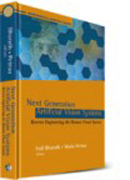
Next generation artificial vision systems: reverse engineering the human visual system
Petrou, María
Bharath, Anil
Artificial sight for the blind? We're not there yet, but this interdisciplinary guide explores the dramatic breakthroughs that now bring us to the brink. It is the first work that integrates the full range of physiological, engineering, and mathematical aspects driving the new technologies inspired by human sight, and explains the latest advances in everything from organic light sensorsto devices that replicate spatial and temporal processing in the brain. Emphasizing both the devices and the software simulation point of view, the book provides retinal cell and primary visual cortex (V1) models that reflect our advancing understanding of visual signal communication networks. It explores design and fabrication considerations behind real-world implementations like semiconductor photosensors that mimic human rods and cones, circuitry that perform retinal processing, and wavelet-based visual detection systems. Engineers and researchers get the latest resolution and motion detection enhancement techniques, together with analytical tools needed to tackle the challenges ahead. INDICE: Introduction. Organic Semiconductor Photoreceptors to Mimic Human Rods and Cones. Analog Retinomorphic Circuitry to Perform Retinal and Retinal Inspired Processing. Retinal Cell Modeling. Image Processing with Irregular Sampling Patterns. V1 Modeling. Analog Modeling of V1. Wavelet Models for V1. From Algorithm to Hardware Implementation. Real-Time Saliency Maps. Reverse Engineering of Human Vision: Hyperacuity and Super Resolution. Motion Detection and Tracking by Mimicking Neurological Dorsal/Ventral Pathways.
- ISBN: 978-1-59693-224-1
- Editorial: Artech House
- Encuadernacion: Cartoné
- Páginas: 220
- Fecha Publicación: 01/07/2008
- Nº Volúmenes: 1
- Idioma: Inglés
